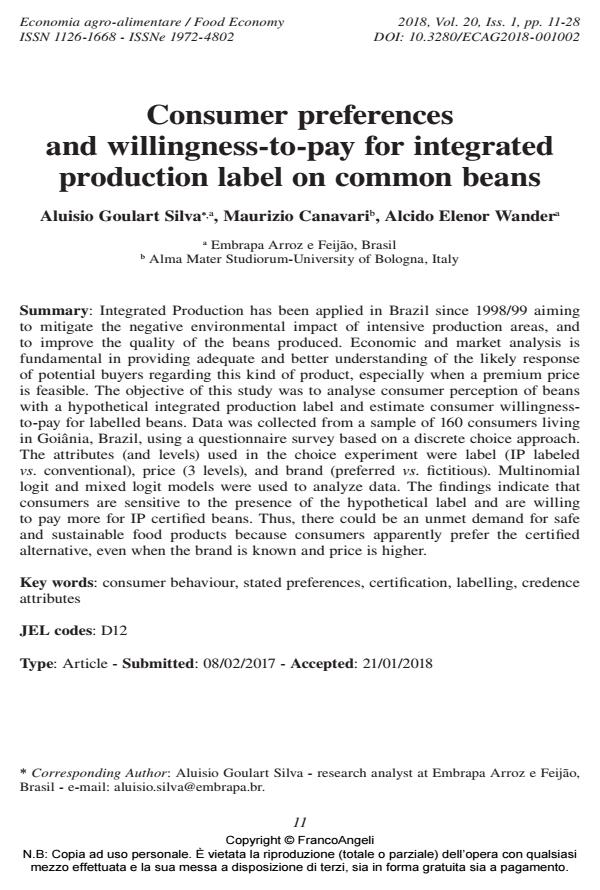Consumer preferences and willingness-to-pay for integrated production label on common beans
Journal title ECONOMIA AGRO-ALIMENTARE
Author/s Aluisio Goulart Silva, Maurizio Canavari, Alcido Elenor Wander
Publishing Year 2018 Issue 2018/1
Language English Pages 18 P. 11-28 File size 162 KB
DOI 10.3280/ECAG2018-001002
DOI is like a bar code for intellectual property: to have more infomation
click here
Below, you can see the article first page
If you want to buy this article in PDF format, you can do it, following the instructions to buy download credits

FrancoAngeli is member of Publishers International Linking Association, Inc (PILA), a not-for-profit association which run the CrossRef service enabling links to and from online scholarly content.
Integrated Production has been applied in Brazil since 1998/99 aiming to mitigate the negative environmental impact of intensive production areas, and to improve the quality of the beans produced. Economic and market analysis is fundamental in providing adequate and better understanding of the likely response of potential buyers regarding this kind of product, especially when a premium price is feasible. The objective of this study was to analyse consumer perception of beans with a hypothetical integrated production label and estimate consumer willingnessto-pay for labelled beans. Data was collected from a sample of 160 consumers living in Goiânia, Brazil, using a questionnaire survey based on a discrete choice approach. The attributes (and levels) used in the choice experiment were label (IP labeled vs. conventional), price (3 levels), and brand (preferred vs. fictitious). Multinomial logit and mixed logit models were used to analyze data. The findings indicate that consumers are sensitive to the presence of the hypothetical label and are willing to pay more for IP certified beans. Thus, there could be an unmet demand for safe and sustainable food products because consumers apparently prefer the certified alternative, even when the brand is known and price is higher.
Keywords: Consumer behaviour, stated preferences, certification, labelling, credence attributes
Jel codes: D12
- Sustainability certification of bio-based products: Systematic literature review of socio-economic impacts along the supply chain Costanza Rossi, Li Shen, Martin Junginger, Birka Wicke, in Journal of Cleaner Production 143079/2024 pp.143079
DOI: 10.1016/j.jclepro.2024.143079 - Consumer preference and willingness to pay for certified high-iron beans among urban households in West Pokot County, Kenya Donald Kiprono Kirwa, Eric Obedy Gido, Charles Karani, in Cogent Food & Agriculture 2448602/2025
DOI: 10.1080/23311932.2024.2448602 - Are Short Food Supply Chains an Alternative to Traditional Retailing? A Study of Preferences for Olive Oil in Spain Olda Lami, Carlos Díaz-Caro, Francisco Javier Mesías, in SSRN Electronic Journal /2022
DOI: 10.2139/ssrn.4056811 - Are short food supply chains a sustainable alternative to traditional retailing? A choice experiment study on olive oil in Spain Olda Lami, Carlos Díaz-Caro, Francisco Javier Mesías, in Economía Agraria y Recursos Naturales /2023 pp.131
DOI: 10.7201/earn.2023.01.05
Aluisio Goulart Silva, Maurizio Canavari, Alcido Elenor Wander, Consumer preferences and willingness-to-pay for integrated production label on common beans in "ECONOMIA AGRO-ALIMENTARE" 1/2018, pp 11-28, DOI: 10.3280/ECAG2018-001002